A pictorial history of Perth's first licenced aerodrome, which operated from 1924 until 1963
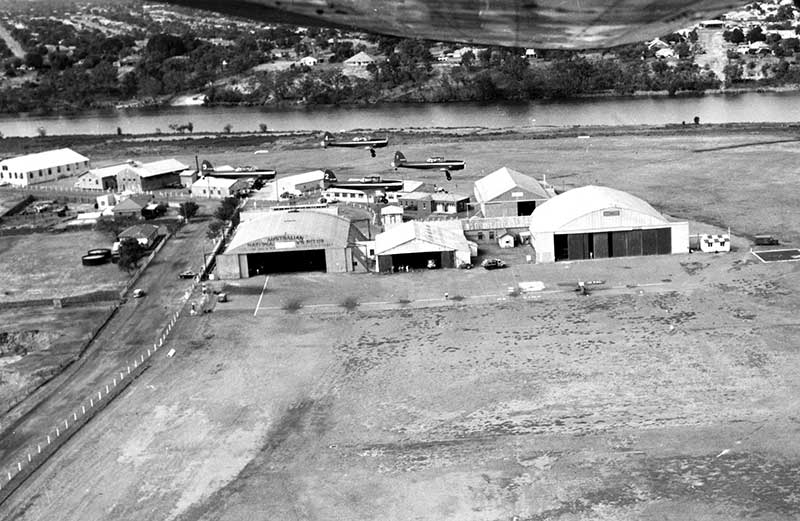
when the Club moved from Maylands to the nearby Perth Airport (Guildford). Geoff Goodall collection

Geoff Goodall collection
WAA had been the successful bidder for the Australian Government's first airmail service between Geraldton and Derby along the WA coastline. For details refer West Australian Airways - Part 1 in this series.
To protect Government railways, the contract stipulated that the airmail sacks and passengers (maximum two) travelled by rail between Perth and Geraldton. Landing grounds would be provided by the Government through the Department of Defence Civil Aviation Board (a predecessor of the Department of Civil Aviation). These roughly cleared airfields along the route proved grossly unsuitable and after the return of the inaugural WAA service in December 1921, Brearley suspended further services for several months until the CAB improved the airfields. For the next two years WAA used The Esplande landing ground for maintenance of its own aircraft, erecting a bigger hangar.

Sir Normal Brearley collection

Frank Walters Collection courtesy Dave Eyre
With this change to the airmail contract came the obligation on the CAB to provide a landing ground for Perth. The Board was located in Melbourne and had no employees in WA at that time. Negotiations to acquire land were carried out by Commonwealth Government departments 2,000 miles away on the other side of the country. An area of flat farming ground on the Maylands Peninsular on the Swan River was selected, 131 acres (52 hectares) of approximately rectangular shape being acquired by the Commonwealth Government and Gazetted in November 1923 as the site for Maylands Aerodrome. The purchase was despite the ominous Commonwealth Surveyor's report which was to haunt officialdom for the next 40 years:
"The land is mostly low-lying and during the winter months apparently gets very soft and sticky. The surface is somewhat rough, a great part having been ploughed at one time and cattle grazing over it when wet has cut it up rather badly. There was no surface water at the time of the survey except a little near the North West corner of Lot 532 and that was fast drying up. There are several drains traversing this land which have their greatest depth of two feet near the river."
CAB Superintendent of Aerodromes, Captain Edgar C. Johnson arrived in Perth by train from Melbourne on 12 December 1923 to supervise the earthworks to level the surface and prepare the land for use as an aerodrome. A temporary hangar was erected for WAA prior to their hangar being moved from The Esplanade.
First aircraft to use the airfield was a WAA Bristol Tourer on 15 January 1924 arriving from Broome, the final sector Geraldton to Maylands flown by company pilot Keith Anderson. The inaugural WAA Perth-Derby service departed that same day. The WAA service now settled into a steady schedule of a Bristol departing Maylands at 6am each Thursday, returning from Derby via all ports the following Tuesday. The airline also conducted charter flights and joyriding at Maylands From late 1924 the Bristols were supplemented, then replaced, by DH.50 biplanes. The WAA Bristol Tourers gave excellent service, flying over a half million miles and carrying over 3,000 passengers.

Sir Norman Brearley collection

This photo by WAA engineer Frank Colquhoun was taken after 1929 when its registration was changed to VH-UEQ.
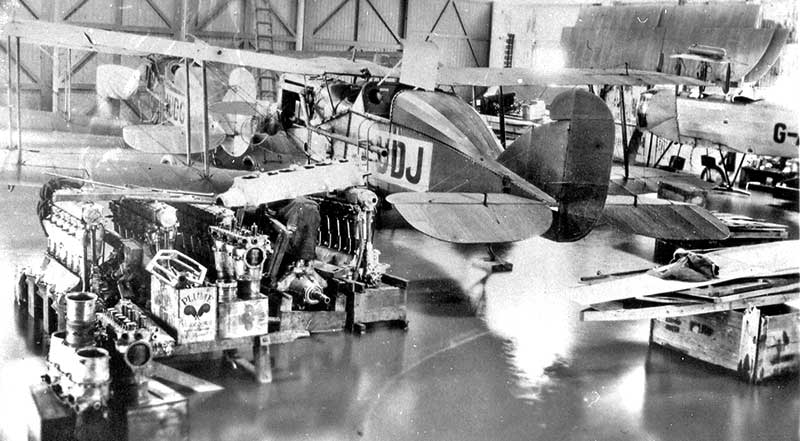
Because there was no aero club in Perth, WAA submitted a detailed application for the Perth subsidy, based on DH.60 Moth training aircraft which WAA would construct at Maylands under licence. During a personal visit to De Havilland Aircraft Co in England to discuss purchase and licenced construction of DH.50s to replace his Bristol Tourers, the canny Norman Brearley had negotiated approval to also build DH.60s. He had full confidence in the hangar staff who had already repaired extensively damaged Bristols and constructed two new Bristols from spare parts and crashed airframes.


The Perth brickworks chimney features in the background of many Maylands photographs. Geoff Goodall collection
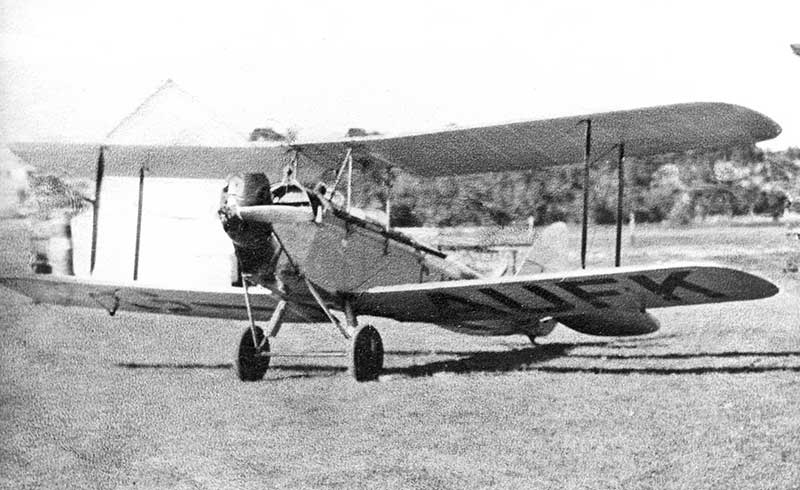
Geoff Goodall collection
The inaugural Transcontinental service departed Maylands on 26 May 1929, when a large crowd watched DH.66 G-AUJO flown by Norman Brearley and Bert Heath take off bound for Adelaide. It was accompanied by G-AUJP flown by Stan Brearley and Eric Chater to be positioned at Kalgoorlie. The DH.66s were later replaced by Vickers Viastra monoplanes, DH.84 Dragon and a DH.89 Rapide.


The new WAA hangar is next to the smaller original hangar with AIRWAYS on the roof. The DH.66 Hercules and
two DH.50s were ready to start a busy afternoon's joy riding. Geoff Goodall collection

Frank Colquhoun collection

Maylands Aerodrome. The Perth suburb of Rivervale is on the other side. Frank Colquhoun collection
"Aero Club members made their appointments with instructor Eric Chater. The tram service had been extended but it was still a walk to the aerodrome. First arrivals helped chase livestock from the airfield and pull the Moths from the hangar. Some newcomers looking for the Club had instead found Charles Nesbit and Charles Snook's Western Aerial Services where they received a ready welcome. The club house was being used by staff of Wings Ltd and WAA. The lock was changed - that brought a touching appeal from West Australian Airways: our building contained the only lavatories, so could two, accessable externally, be left unlocked until appropriate alterations were made to Airways premises."
A hangar was built by club members during 1932, its construction hampered by waterlogged ground. As the club grew it was renamed Aero Club of WA Inc, then Royal Aero Club of WA Inc. The DH.60 Moth fleet was enhanced in the late 1930s by brand new DH.94 Moth Minors, DH.82 Tiger Moth and DH.87 Hornet Moth.


Geoff Goodall collection

across the Swan River to the Perth suburb of Rivervale on the the other side of the river. Geoff Goodall collection

This photograph shows his final Perth visit, 9 September 1934 arriving in the Lockheed Altair "Lady Southern Cross" after
breaking the Melbourne-Perth record with a 10 hour 22 minute non-stop flight. Geoff Goodall collection
West Australian Airways lost the airmail contract for the North West coastal route Perth-Wyndham to a small Adelaide operator MacRobertson Miller Aviation Co. WAA was forced to shed staff and aircraft while continuing its Perth-Adelaide service for which subsidies were dropped. It was payback for the years of WAA Managing Director Norman Brearley's high-minded dealings with the CAB. By 1936 Brearley was frustrated that his various plans to expand WAA, including international routes in partnership with KLM, had been thwarted by officialdom. The Adelaide route was stuggling financially and was being maintained with a single DH.89 Rapide. He gained agreement from his fellow directors to accept an offer to purchase the business from Adelaide Airways Ltd.
Effective 1st July 1936 WAA was no more, absorbed into Adelaide Airways. This was a step in the formation of a new Australia-wide air servic Australian National Airways Pty Ltd. ANA absorbed Adelaide Airways effective 2 November 1936 and took over its routes, including the Adelaide-Perth service. Soon ANA was flying their new Douglas DC-2s Adelaide-Perth in a single day, a massive improvement. Meanwhile a new Perth airline was founded, Airlines (WA) Ltd. which flew services from Maylands to WA inland towns.
The Maylands aerodrome surface was to be a continuing problem during this expansion in passenger flights. One memorable occasion occurred on 29 October 1936 when MMA Dragon VH-URY was taking off for a scheduled North West service - pilot George McCausland abandoned his takeoff run when one engine lost power, but could not stop in time to avoid rolling into an airfield drainage channel. His wife, watching the departure from the hangar in the family car, drove across the aerodrome to the disabled Dragon, but her car was struck by a landing Aero Club DH.60 Moth VH-UAO which overturned. Remarkably nobody was hurt.
Founded at Adelaide by Horace C.Miller in 1928 with the financial backing of Melbourne businessman McPherson Robertson. During 1934 in preparation for the proposed England-Australia Air Mail Service, Australia's Government-subsidised air mail routes were revised to provide connections with the International service for outbound and inbound airmail. Tenders were invited for new subsidised routes, including WAA's long-established Perth-Wyndham route, which would be extended to Daly Waters NT to connect with a Brisbane-Darwin route. In Adelaide Horrie Miller gave a lot of thought to the WAA route and believed he could undercut the existing subsidy rate. He submitted a detailed tender professionally drawn up by the MacRobertson's company accountants, based on three new DH.84 Dragons.
To the surprise of all, the world class West Australian Airways lost the route they had operated since 1921 to a small Adelaide company.
Miller flew his DH.60 Moth fom Adelaide to Perth in June 1934 to set up MMA's Perth-based operation. A new hangar at Maylands was essential but the site allocated by CAB in Melbourne turned out to be a muddy quagmire from the airfield's ongoing drainage problems. The hangar was only partially constructed by August when the three DH.84 Dragons arrived in wooden crates by sea from England. Miller began their assembly in the open weather. The inaugural MMA service departed Maylands for Daly Waters on schedule 3 October 1934. Despite early accidents, MMA's WA service became a reliable airmail and passenger airline. In August 1938 the route was extended from Daly Waters to Darwin, to connect with Qantas flying boats on the new Empire Air Mail Service. MMA introduced ex-Qantas DH.86s and Lockheed 10A Electras on the long haul Perth-Darwin route which it was to operate for the next 50 years.

pilots Bert Hussey, who was to go on to a stellar career with Qantas. Geoff Goodall collection
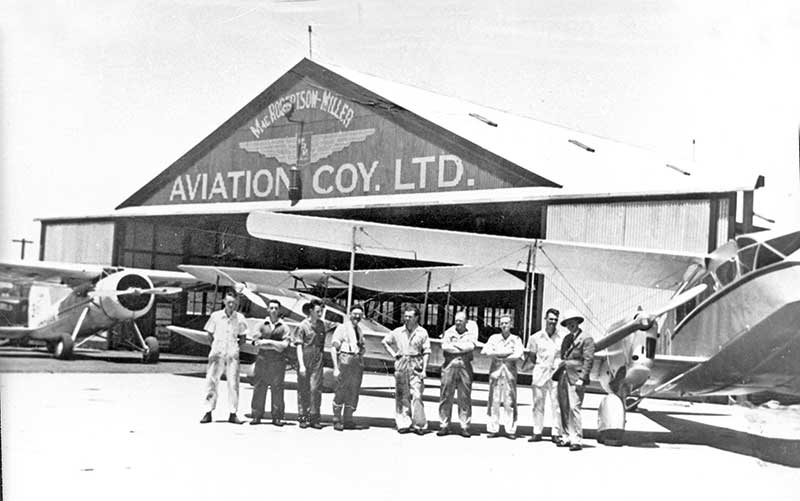
MMA staff pose outside the Maylands hangar 1937 with MMA aircraft: Lockheed Vega VH-UVK at left, a DH.83 Fox Moth
used for Flying Doctor Service contracts at Port Hedland and Wyndham, and DH.84 Dragon. Frank Colquhoun collection
used for Flying Doctor Service contracts at Port Hedland and Wyndham, and DH.84 Dragon. Frank Colquhoun collection
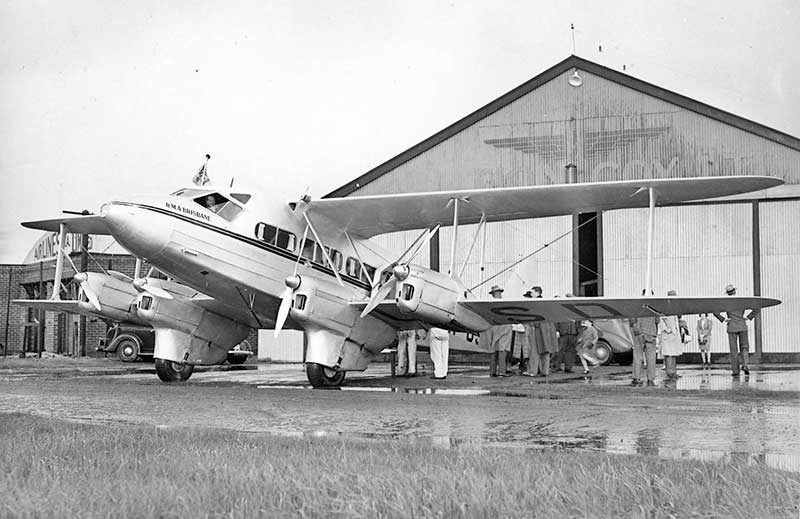

preparing for the inaugural Lockheed service to Darwin. MMA name and wings emblem painted on the hangar has faded
from exposure to the afternoon sun. The frugal Horrie Miller did not have it repainted. Geoff Goodall collection
He had a hangar built at Maylands and ordered the first aircraft, a new 5 passenger General Aircraft Monospar VH-UVJ shipped from England. It was christened Miss Wiluna in a ceremony at Maylands on 9 December 1935 before Snook departed on the inaugural service Perth-Mount Magnet-Wiluna-Kalgoorlie-Perth. The Wiluna service was run weekly in alternate directions, using a variety of aircraft, also scheduled services to Rottnest Island. The company was referred to locally as "Airlines" (just as WAA was known as "Airways").

Geoff Goodall collection

Stinson Reliant VH-UTW "Meekatharra". Geoff Goodall collection

On 1st July 1936, Adelaide Airways took over the East-West service when their DH.89 VH-UVI operated Forrest-Ceduna-Adelaide, flown by Captain L. M. Diprose.
For the next 4 months the Maylands-Adelaide service was operated by Adelaide Airways DH.89 Rapides VH-UVI, VH-UVT and VH-UUO acquired fom WAA. However during 1936 behind the scenes business agreements were being made which would significantly change the Australian airline scene. Adelaide Airways was backed by the Adelaide Steamship Line, which joined with other shipping companies in a visionary plan to merge established airlines into a new Australia-wide operation to be named Australian National Airways.
ANA was to grow to become the leading Australian airline, for which the postwar Labor Government established Trans-Australia Airlines (TAA) to provide competition until 1958 when in a machiavellian move, ANA was taken over by the much smaller Ansett Airways to become Ansett-ANA, later Ansett Airlines of Australia.
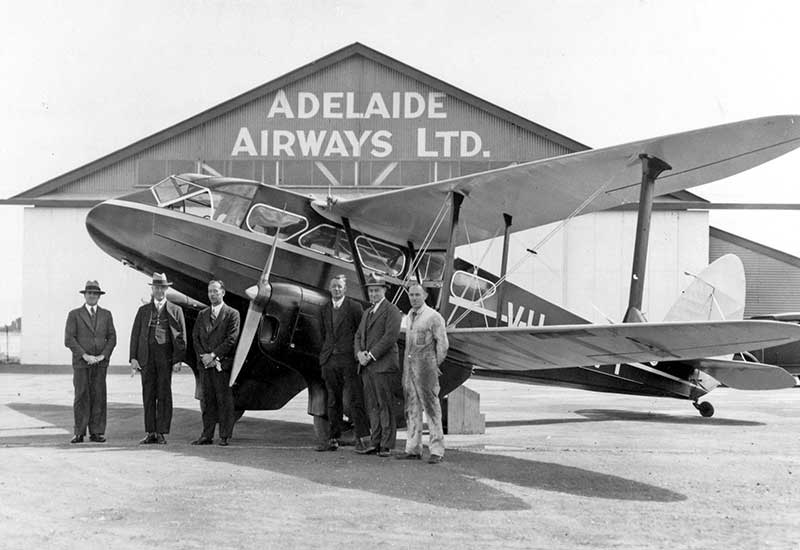
The all-metal DC-2s were a vast improvement over the previous aircraft types used on the long route. Although there were still stops at Kalgoorlie, Forrest and Ceduna, the trip each way was now done in one day, passengers enjoying meals served in flight by an air hostess.
Bob Giles wrote "ANA's new flagship, the first DC-2 "Bungana"arrived at Maylands one Sunday afternoon. With pennant flying and crew Captains Norman Croucher and Harry F.Baker resplendent in Navy style uniform of blue, white cap, gold braid and brass buttons, it was quite a spectacle from the Aero Club clubhouse."

the first DC-2 Perth-Adelaide service pose at Maylands before departure. Captain Harry "Cannonball" Baker far left,
copilot Bill Heath far right with radio operator W.E. Lauder-Cridge, hostess Gladys Allen fourth from left.
Photo: Macarthur Job collection, Civil Aviation Historical Society,

at the back of the main hangar where it was stored until broken-up in 1939. Australian Aircraft Restoration Group Collection

(ex WAA) as liason officer. Charles Snook turned part of the Airlines(WA) Ltd hangar into a dormitory and the club house provided meals. Club manager at the time, R.O.Giles, recalls receiving mail adressed to "The Manager No.9 EFTS"even though that unit had yet to be established, and the single club telephone line ringing continuously with RAAF instructions and requests from 6am (8am at RAAF HQ Melbourne) until dark every day.
When the air force established No.9 EFTS at Cunderdin, 70 miles inland from Perth, the Aero Club was advised their training aircraft would be impressed in July 1940 for use by RAAF. However the Club's maintenance facilites and staff were expanded to construct spare parts for 9EFTS DH.60 Moths and DH.82 Tiger Moths.

Royal Aero Club of WA DH.60 Moths impressed by the Government for RAAF waiting to be collected in July 1940.
They are parked at the MMA hangar, in which RAAF liaison officer Sqn Ldr Norman Brearley had an office.
A7-92 was the former VH-UAO, which is still flying today. Geoff Goodall collection
They are parked at the MMA hangar, in which RAAF liaison officer Sqn Ldr Norman Brearley had an office.
A7-92 was the former VH-UAO, which is still flying today. Geoff Goodall collection
As part of the war effort, the Maylands hangar workshops of MMA and ANA were included in an country-wide Department of Aircraft Production scheme for "Approved Civilian Contractors" to carry out repair and overhauls of selected military aircraft types. ANA was contracted to receive RAAF Avro Ansons from 4SFTS Geraldton for scheduled major overhauls, while MMA received RAAF Tiger Moths from 9EFTS Cuderdin. This reduced workshop delays at RAAF bases while allowed the airlines to maintain, and in fact expand, their maintenance facilities and staff. DAP built a second hangar for MMA for the Tiger Moth reconditioning. Many women were employed on a range of duties, especially airframe fabric work. This included fabric control surfaces for US Navy Catalinas and single-engined floatplanes based on the Swan River at Crawley Bay on the other side of the city. The smaller Curtiss SOC and Vought OS2U floatplanes sometimes landed on the river on the Maylands boundary to be hoisted on to the aerodrome.
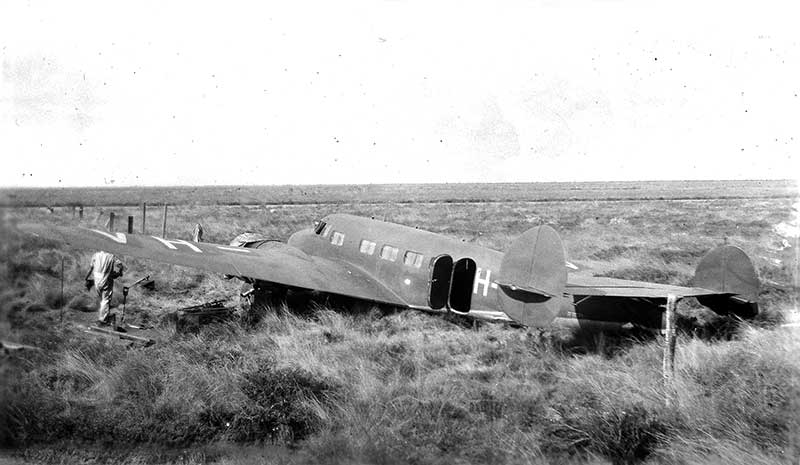
MMA Lockheed 10A VH-ABV painted in camouflage damaged on takeoff Port Hedland in March 1943 when it struck runway
obstructions and piles of gravel to the side of the strip, to be used to disable the runway in the event of Japanese invasion.
Frank Colquhoun collection
obstructions and piles of gravel to the side of the strip, to be used to disable the runway in the event of Japanese invasion.
Frank Colquhoun collection

RAAF Avro Anson wooden mainplane is detached from the fuselage frame during a wartime overhaul by ANA at Maylands.
Geoff Goodall collection
Geoff Goodall collection

The war arrived at Maylands in February 1942 when 32 USAAC Curtiss P-40s flew in, one colliding with the windsock pole during its landing roll. They had been ferried from Brisbane where they were assembled from the first US military shipping convoy. They were intended to be loaded at Darwin on the seaplane tender USS Langley for shipping to Java as reinforcements for American forces defending the Netherlands East Indies against Japanese advances. But Langley was diverted to Perth because of Japanese air raids on Darwin. Armourers from Pearce cleaned the P-40 guns and loaded ammunition before they were towed on their main wheels along Stirling Highway to Fremantle port wher they were hoisted on to the ship's deck. Carrying the P-40s and their crews, USS Langley departed Fremantle on 22 February in a convoy of US and Australian warships. Five days later off the Java coast Langley was lost in a Japanese air attack, 31 of the 32 P-40 pilots died.
RAAF Station Pearce, 15 miles north was struggling to accommodate the extra RAAF units and aircraft hastily sent to defend Perth and patrol the WA coastline. In April 1942 the Aero Club clubhouse was taken over by RAAF for use by personnel of newly formed units yet to receive aircraft. These included No.77 (Fighter) Squadron, whose first allocation of P-40E Kittyhawks were assembled at Maylands, and No.35 (Transport) Squadron. Because of a desperate lack of transport aircraft, 35 Sqn made do with a motley collection of Fox Moth, Tiger Moths, Dragons, Ansons, Battles and even the Northrop Delta taken over by the Australian Government from the Ellsworth Antarctic Expediton. In August 1943 RAAF presence at Maylands ended when 35 Sqn relocated to Pearce to re-equip with Dakotas.
As Allied military forces in NEI fell back towards Australia, during February-March 1942 many evacuation flights, civil and military arrived unannounced on the northern WA coast at Broome and Port Hedland. Most picked their way down the coast to Perth, finding fuel where they could, then across the country to Melbourne or Sydney.

Geoff Goodall collection


during February-March 1942, most carrying family and refugees. Note the armed guard. Geoff Goodall collection

outside its hangar facing the Swan River, with suburban Rivervale on the other side. Civil Aviation Historical Society

Geoff Goodall collection
In 1944 Qantas Empire Airways were issued former BOAC Liberators to supplement their Catalina flying boats operating the secret wartime Perth (Swan River) to Colombo and Karachi service The Secret Order of the Double Sunrise. Such was the strategic importance of the Indian Ocean route to Commonwealth war communications that QEA was approved to use Guildford. The Liberators with heavy fuel loads could not operate from Mayland's soft surface. A new hangar and sealed apron was built for QEA some distance from the RAAF facilities. ANA was also given permission to use Guildford as the Perth terminus for its DC-2 and DC-3 civilian services. No.85 Squadron's duties included the refuelling of civilian airliners at Guildford. As the Pacific war came to an end, a joint BOAC-QEA London-Sydney service was introduced with Avro Lancastrians which staged Colombo-Learmonth-Perth (Guildford)-Gawler-Sydney, later dropping the Perth stop.
After V-J Day RAAF units were moved or disbanded. In 1946 Guildford airfield with its hangars and faciliies was handed over to the Department of Civil Aviation to become Perth Airport.

7CU used Tiger Moths for routine deliveries of orders and despatches to Cunderdin and Geraldton RAAF stations.
The hangar behind was later used by MMA. Photo by Harley Fairclough via Geoff Goodall collection
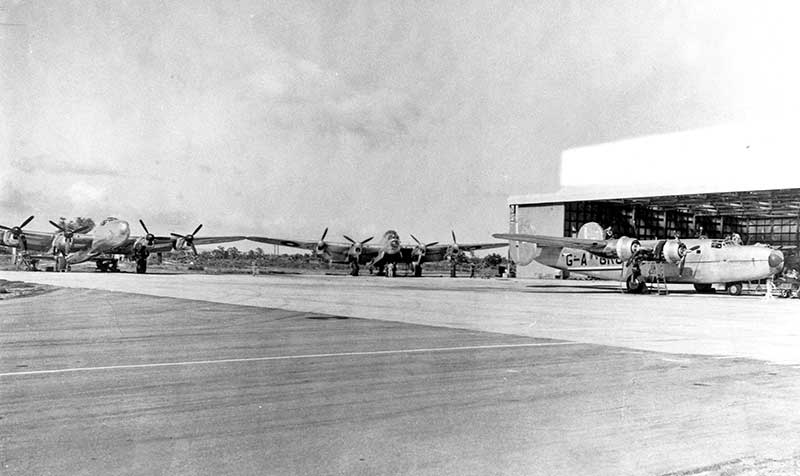
for Lancastrian pilot training, QEA Liberator G-AGKU with its earlier camouflage paintwork removed. After the war this hangar
was taken over by ANA and survived into the next Century as the Perth Airport Ansett Air Freight hangar. Photo: Qantas
During this time, neat and tidy Maylands resembled a junk yard with up to a dozen Ansons in faded RAAF camouflage or trainer yellow parked in various states of disrepair while they were stripped of engines and parts to complete civilianised Ansons in the hangars.

It entered service with the airline as VH-BAU in December that year. Photo by Ern Flanders
Maylands aerodrome continued to be poorly served by public transport buses and the Maylands railway station was too distant. Aero club staff gathered each morning on the Rivervale side of the Swan River to use a dinghy to row to work.
Australia-wide Commonwealth Disposals Commission sales of large stocks of retired RAAF aircraft, engines and equipment were held during 1946-1948. This helped start postwar private and commercial flying at Maylands because Tiger Moths could be purchased from £400.
David Gray & Co (David Gray)
Aero Service Pty Ltd (Cyril Flood)
Basil Taylor & Co Pty Ltd (Basil Taylor)
Doggett Aviation (Stan Doggett)
For details refer: WA Aerial Agricultural Operators on this website

Photo via Cyril Flood
Few light aircaft were equipped with radio and Maylands aircraft movement statistics did not justify a DCA control tower. An aero club Duty Pilot watched the circuit during busy times, using an Aldis Lamp to flash red, green and white standard light signals to pilots.
As early as 1947 the Club had ordered new British-built DHC-1 Chipmunks as Tiger Moth replacements, but they were unavailable due priority military production. In early 1951 two new Chipmunks were made available and shipped in wooden crates from England in April. For reasons known only to the shipping line, they eventually reached Perth in December 1951. Quickly assembled in the Club hangar, the pair were registered VH-AMB and VH-ROG in honour of long-serving Club presidents A.Mervyn Bay and Robert O. Giles. The Chipmunks proved an immediate success and the Club purchased 11 more over the next seven years, all ex military disposals.


VH-ROG (R.O.Giles), VH-AMB (A.M.Bay) and VH-WRW "Chippie 3". Geoff Goodall collection

One of the nine former RAF Chipmunks acquired by the Aero Club being removed from its shipping crate at Maylands 1955.
WG404 had served with the Rhodesian Air Training Group before being sold on the civil market by a South African dealer.
Registered VH-RCW in May 1955, it was wrecked in an accident in the Bull Creek training area in December 1956.
Geoff Goodall collection
WG404 had served with the Rhodesian Air Training Group before being sold on the civil market by a South African dealer.
Registered VH-RCW in May 1955, it was wrecked in an accident in the Bull Creek training area in December 1956.
Geoff Goodall collection
Tiger Moths 1 to 6, Chipmunks (all painted bright red with white trim) 1 to 8, and the later Cessnas 11 to 14.
With so many training aircraft, Maylands had occasional aircraft accidents, including ground collisions between tailwheel aircraft with limited forward visibility. Happily few resulted in serious injuries.

The Chipmunk was a write-off but the Tiger was rebuilt as a crop duster. Geoff Goodall collection


only to suffer the indignity of a gear collapse on arrival Maylands 14 January 1954. It was quickly repaired and sold as VH-BTP.
Geoff Goodall collection

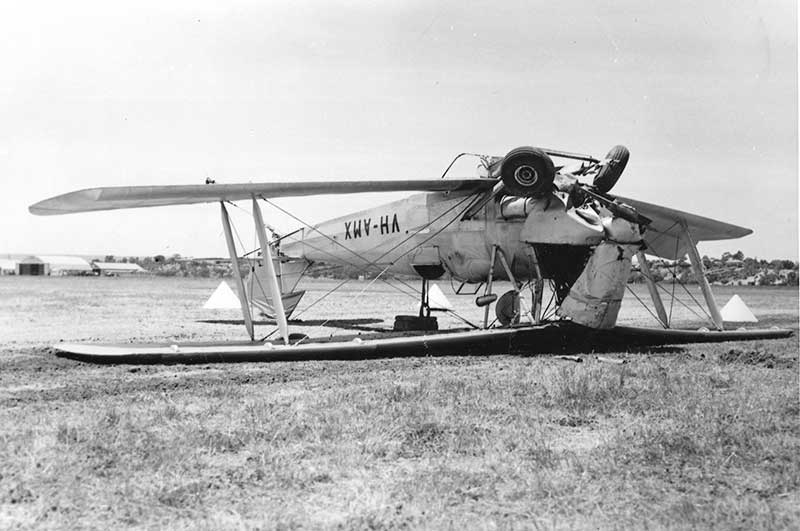
on 31 January 1958. Pilot Harold "Slim" Summerfield was unhurt and the Tiger promptly rebuilt. Geoff Goodall collection

The Rearwin's Le Blonde radial engine had been replaced by a Gipsy Major. Geoff Goodall collection

repaint in striking ivory and velox colours. The brickworks chimneys dominate the background Photo by Don Ende

veteran airliner on contract at the Meekatharra WA Royal Flying Doctor Service base. Modifications include Gipsy Major
engines and double landing lights in the nose. Photo by Meekatharra RFDS pilot Don Ende

fuel truck in June 1959. The rear fuselage fabric was routinely removed for ease of maintenance. Geoff Goodall collection

The hangar clearly reveals its former use by MMA. Photo by Don Ende

clearly revealed its ANA past. A third 172 VH-RWD was delivered that month. Geoff Goodall collection
"In April 1959 the Club was ordered to vacate Maylands at a fortnight's notice. Apparently there had been one too many complaints of club aircraft in Guilford's flight paths at the wrong time. The Department had planned to move the Club into buildings erected by ANA in 1946 which were to be vacated when ANA moved its administration into the newly constructed airline terminal building. But ANA were still waiting for their new premises to be completed. Thus the club moved into empty rooms in six different buildings. Workshop, hangar and office equipment, stores, spares and furniture went whenever they could be unloaded from DCA trucks. On 23 April CFI Harry Beeck led the Club aircraft to their new home in an annexe of the ANA hangar and flying went on uninterrupted."
Late that year Club administration and classroom instruction moved into the vacated ANA buildings next to the ANA hangar (later more familiar as the Ansett Air Freight hangar) and things settled down. However the loss of Mayland's convivial club house atmosphere was much lamented and membership numbers dropped. DCA stressed that Guildford was just a temporary home while waiting for the new Jandakot Airport to be constructed.

All club aircraft now required radio and were controlled by Perth Tower. Geoff Goodall collection
1959-1963 Maylands Aerodrome final years
Maylands Aerodrome never had a control tower. ATC at Perth Airport placed restrictions on Maylands circuit operations when required by traffic at Perth, and pilots of Maylands travel flights telephoned Perth Tower for clearances within set time limits.

The old with the new. One of Doggett Aviation's new Piper Pawnees with a company Tiger Moth sprayer at Maylands 1960.
Geoff Goodall collection
Geoff Goodall collection

Arrival of a new CAC CA-28 Ceres for Doggett Aviation on 20 November 1961. It had been ferried from Fishermans Bend,
Melbourne by aero club instructor Phil Hicks, seen on the right wearing a blazer. Geoff Goodall collection
Melbourne by aero club instructor Phil Hicks, seen on the right wearing a blazer. Geoff Goodall collection

The large former ANA hangar vacated by the Aero Club was now used by Bill Boulden's Air Culture Pty Ltd, which operated
Wackett-Cropmasters then the new Yeoman YA-1 Cropmaster 250s and Cessna 180s. Photo by Mike Madden
Wackett-Cropmasters then the new Yeoman YA-1 Cropmaster 250s and Cessna 180s. Photo by Mike Madden

The Swan River on the Maylands boundary proved handy for floatplanes. Here Cheyenes Beach Whaling Company's
whale spotter Cessna 172C is lifted from the water in March 1962 on arrival from Albany for routine maintenance.
Geoff Goodall collection
whale spotter Cessna 172C is lifted from the water in March 1962 on arrival from Albany for routine maintenance.
Geoff Goodall collection

heritage, the later ANA paintwork stubbornly shows through, perhaps testimony to the quality of 1930s sign-writers paint.
Photo: Civil Aviation Historical Society

WA Police which consolidated the site into the Maylands Police Complex. Photo by Geoff Goodall
- Flypast - A Record of Aviation in Australia, Neville Parnell & Trevor Boughton, Civil Aviation Authority 1988
- Wings In The West, R.O.Giles, published by Royal Aero Club of WA 1980
- Maylands Aerodrome 1923-1963, Ted Fletcher, Perth: research paper
- Tony McGrath: historical documents and reports on Maylands